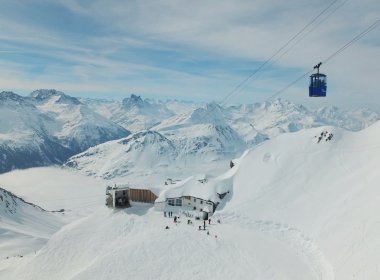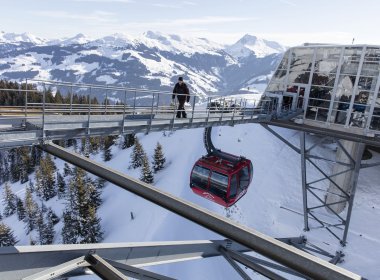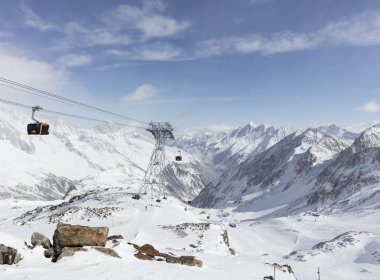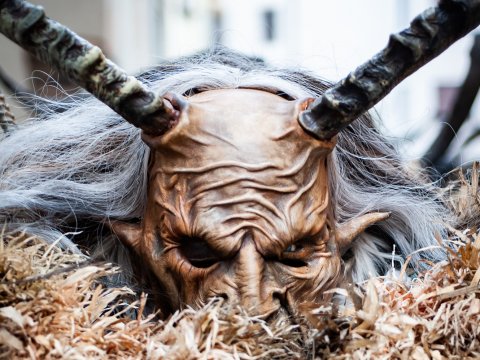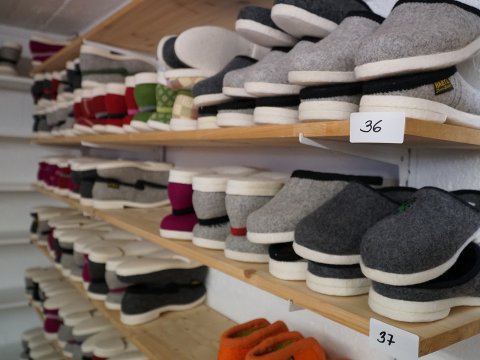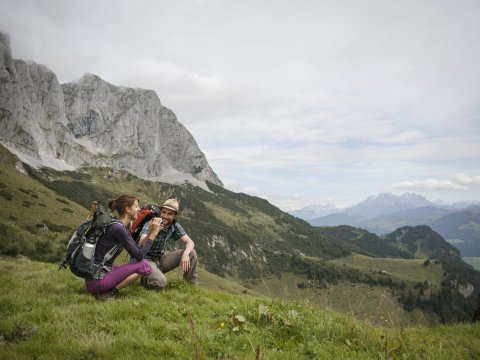Tirol’s Most Spectacular Cable Cars – the Wildspitzbahn on the Pitztal Glacier
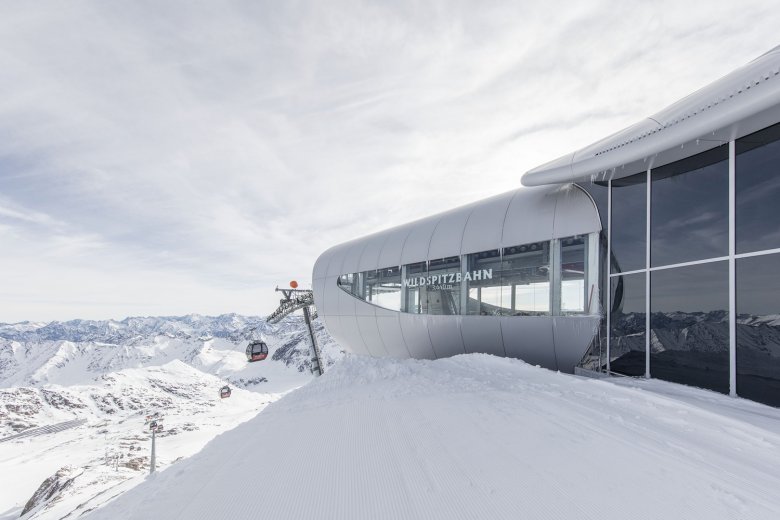
As the crow flies it is just seven kilometres from Sölden in the Ötztal Valley, where we visited the Giggijochbahn, to the Pitztal Glacier. But for those of us who don’t have wings (or, for that matter, a private helicopter) it takes around two hours to drive from one valley to the other. As we pull into the car park, Heiko Rauch is waiting for us. He is the deputy manager of the lifts and cable cars operating on the glacier and tells us that our two-hour drive could soon be a thing of the past if their latest project – a cable car connecting the Stubaital Valley to the Ötztal Valley – is given permission by the local authoriries.

However, that is a dream for the future. We are here to see something which is very much already a reality: the Wildspitzbahn, at 3,440 metres above sea level the highest cable car in Austria.
After a short connecting ride on the Pitzexpress cable car we find ourselves on the stunning Pitztal Glacier. Wherever we look, lifts and cable cars fan out from the middle of the resort to take skiers and boarders up to the nearby peaks. Right at the heart of the action is the Wildspitzbahn with the shiny roof of its bottom station reflecting the rays of the morning sun. We follow the cables with our eyes all the way up to the top station on the Hinterer Brunnenkogel. Just three kilometres further south lies the Wildspitze mountain, which gives the lift its name. At 3,770m it is the highest point in Tirol.

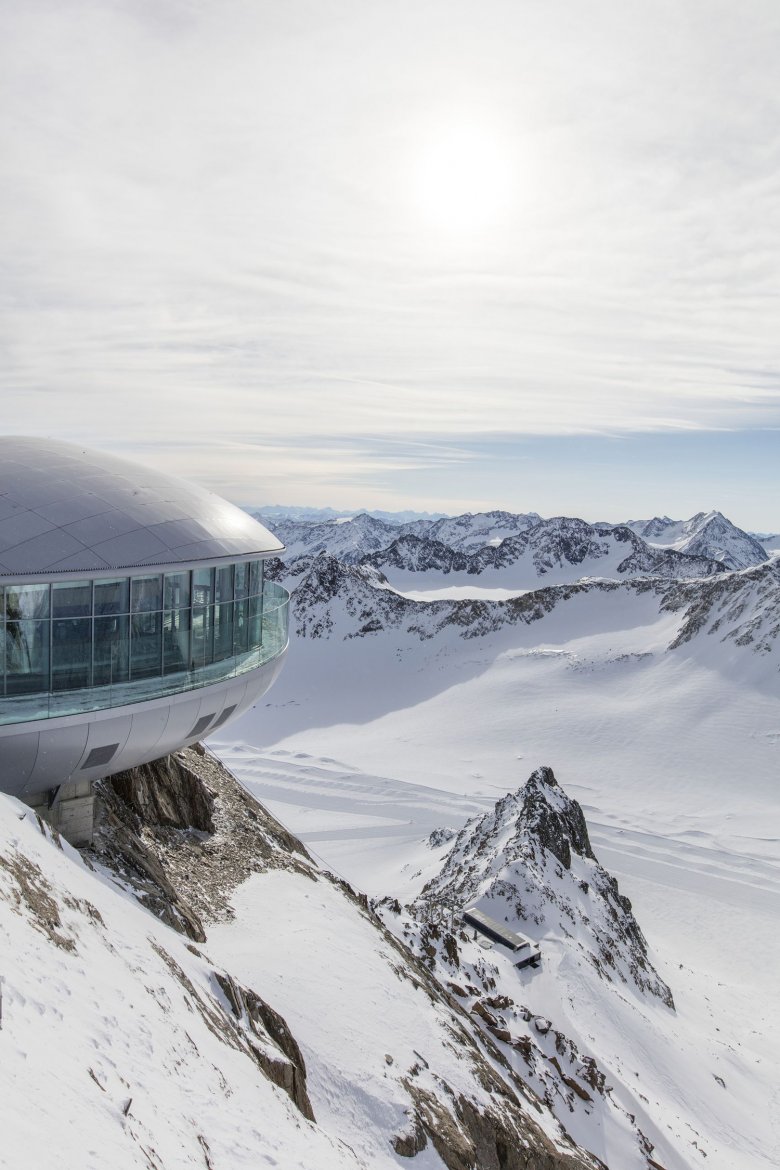
The lifts and cable cars are not yet in operation, so we use the beautiful early morning light to film some shots of the spectacular bottom station which blends in perfectly with its surroundings. While we are busy filming, Heiko carries out a routine check of what is Europe’s highest solar energy plant, located opposite the cable car building. He is almost as proud of this huge bank of solar panels as he is of the Wildspitzbahn itself. “The glacier is the perfect place for collecting solar energy,” he explains. “We get up to 40% more solar energy here than in the valley because the air up here is so clean, the sunlight is stronger and the snow reflects the sun’s light. The solar energy we generate here covers a third of our energy requirements for all the lifts and cable cars in the resort.”

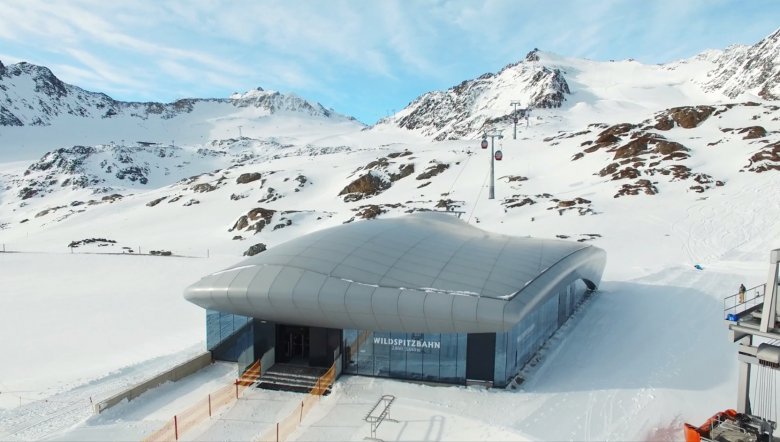
As Heiko speaks, the first gondolas slowly swing into action and leave the bottom station of the Wildspitzbahn. Now it’s finally time to ride up to the famous top station, which houses Austria’s highest café – the appropriately-named Café 3440. The journey is smooth and the ski racks inside each gondola make getting on and off easy. It takes just five and a half minutes to travel the 591 vertical metres from bottom to the eye-catching station at the top perched on the Hinterer Brunnenkogel ridge. “The building blends into the glacier,” says Heiko with more than a little pride in his voice. “It is beautiful. I couldn’t imagine a better place to work.”

We decide that it is time for a coffee and head straight to the Café 3440. The huge glass façade guarantees stunning views of the mountains: the Zugspitze, Germany’s highest mountain, to the north; the Ötztal and Stubai Alps to the east; the mighty Ortler in Italy to the south; and the Arlberg mountains to the west. And standing there, just a few kilometres away, is the queen of them all: the Wildspitze and its mighty Taschachferner glacier. We get chatting to our waitress and soon learn that life this high up in the mountains can be more complicated than you might expect. For example, the pressure in the beer pumps has to be adjusted regularly depending on the weather (bad weather is generally accompanied by low pressure, while high pressure brings clear and calm weather) and up at almost 3,500 metres you need to use a little bit more ground coffee than usual to make a good cappuccino.
But it’s not just objects which are affected by the thin air – we humans are too. As we walk out onto the viewing platform, we can all feel our hearts beating harder than usual and we have to wait for a moment to catch our breath before getting out the camera and filming the majestic panorama.

We decide to get some birds-eye-view images of the building with our camera drone. From above the areas where the gondolas enter and leave look like the tentacles of a mysterious deep-sea animal. The images show how tight space is on the exposed ridge – the whole building covers no more than 200 square metres. We meet up with Heiko’s boss, Reinhold Streng, to learn more about the unique challenges posed by working at this altitude. “The thin air is the first thing. Lots of people have headaches and nausea when they start working here. It takes a while to acclimatise. But what is more of a challenge than the altitude itself is the extreme weather. There is no road up here, so when we built the cable car everything had to be flown in by helicopter or transported up using a separate mini cable car used to carry material.” One thing Reinhold is particularly proud of is that the design hides away all the pipes and wires needed in such a high-tech building. “We ran the water, electricity and waste water supply through the rock all the way down into the valley. All waste we produce here is transported off the glacier.”

After the interview with Reinhold we take the opportunity to go out one more time onto the free-standing terrace at the Café 3440 – after all, we have been told that one of the secrets for dealing with the altitude is to drink plenty! Next to us is a retired couple, both sporting Moonboots, enjoying coffee and cake. Opposite where we are sitting there is a family with young child sitting down to a hearty snack – at 3,440 metres above sea level. Maybe the biggest achievement of this incredible project is that it makes it possible for people of all ages and fitness levels to enjoy what are simply breathtaking views.
“The invention of lifts and cable cars has made many mountains accessible to everyone, not just hikers and climbers. In this series we showcase six extraordinary cable cars in Tirol, each unique in its own individual way.”












